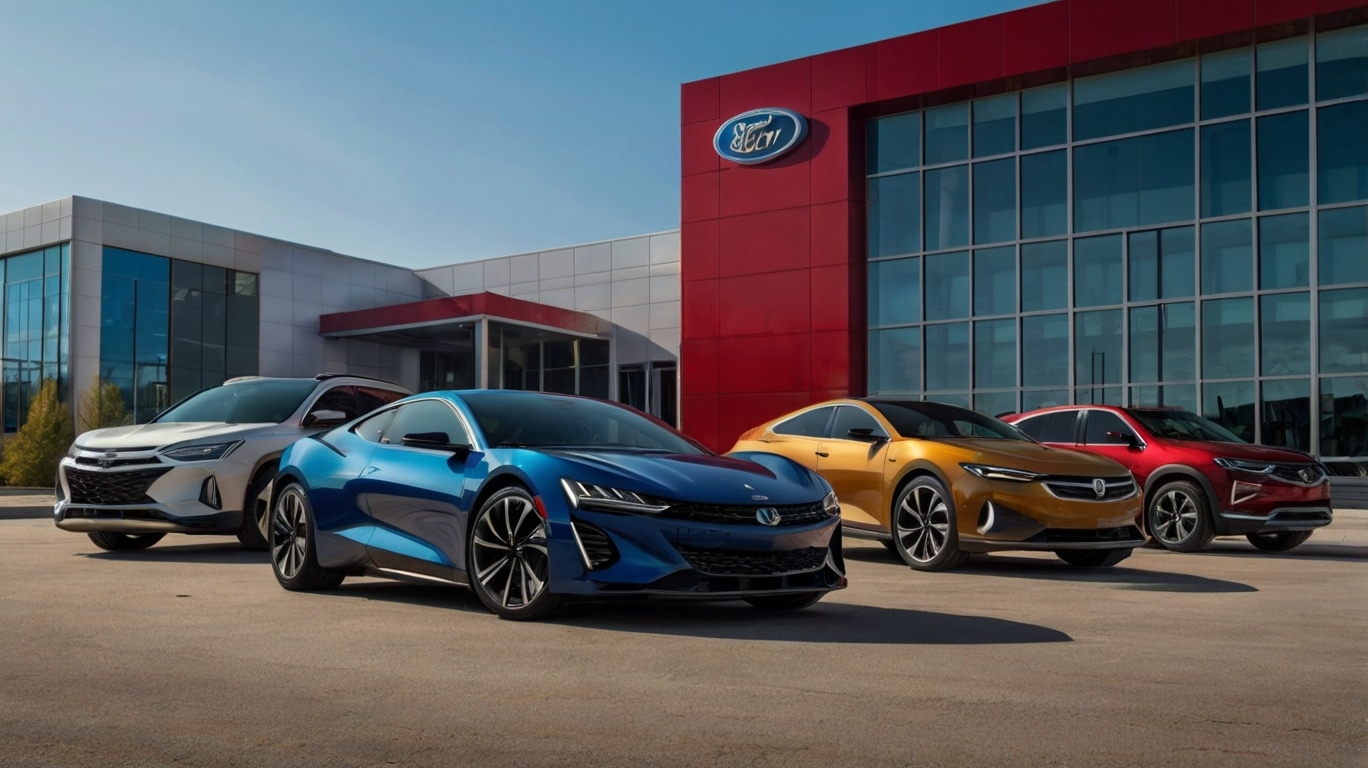American Car Industry Trends 2024: Shaping the Future of Mobility
Introduction
The American car industry is at a pivotal point in 2024, driven by rapid technological advancements, changing consumer preferences, and a shifting regulatory landscape. As one of the largest and most influential automotive markets in the world, the United States is witnessing trends that are not only redefining the industry domestically but also setting the stage for global developments. This article explores the key trends shaping the American car industry in 2024, offering insights into the future of mobility.
1. The Electrification Revolution
a. Expansion of Electric Vehicles (EVs)
The most significant trend in the American car industry in 2024 is the ongoing shift towards electric vehicles (EVs). The electrification of the automotive fleet has accelerated, fueled by growing environmental concerns, advancements in battery technology, and substantial government incentives. In 2024, EVs are no longer a niche market; they are becoming mainstream, with a wide range of models available across various segments, from compact cars to luxury SUVs.
Manufacturers like Tesla, Ford, General Motors, and newcomers like Rivian and Lucid Motors are leading the charge in the EV market. The expansion of EV charging infrastructure across the country has also played a critical role in increasing consumer confidence and adoption rates. Public and private investments in fast-charging networks are making long-distance travel in EVs more feasible, further reducing range anxiety among potential buyers.
b. Battery Technology Innovations

Battery technology is at the heart of the EV revolution. In 2024, significant advancements in battery chemistry, particularly in solid-state batteries, are being commercialized. These batteries offer higher energy density, faster charging times, and improved safety compared to traditional lithium-ion batteries. The development of these next-generation batteries is expected to reduce the overall cost of EVs, making them more accessible to a broader range of consumers.
Moreover, the push for sustainable and ethical sourcing of battery materials, such as cobalt and lithium, is driving innovation in recycling technologies and alternative materials. Companies are investing in closed-loop systems to recycle old batteries, reducing the environmental impact of EV production and helping to create a more sustainable supply chain.
c. Increased Competition and Market Diversification
The growing popularity of EVs has intensified competition among automakers. In 2024, nearly every major automotive manufacturer has a significant EV portfolio. This competition is leading to more diverse offerings in terms of vehicle size, range, and price points. Consumers now have more choices than ever before, whether they are looking for an affordable city commuter or a luxury electric SUV.
Startups are also playing a crucial role in pushing the boundaries of what EVs can offer. Companies like Rivian, Lucid Motors, and Fisker are challenging traditional automakers with innovative designs, cutting-edge technology, and new business models. This increased competition is expected to drive further innovation and accelerate the transition to electric mobility.
2. Autonomous Driving: Moving Closer to Reality
a. Advancements in Autonomous Vehicle (AV) Technology
Autonomous driving technology continues to evolve rapidly in 2024. While fully autonomous vehicles (Level 5) are not yet a common sight on American roads, significant progress has been made in achieving higher levels of autonomy. Many vehicles now come equipped with advanced driver-assistance systems (ADAS) that offer features such as adaptive cruise control, lane-keeping assist, and automated parking.
Several companies, including Tesla, Waymo, and General Motors’ Cruise division, are conducting extensive testing of autonomous vehicles on public roads. These tests are crucial for refining the technology and ensuring its safety and reliability. In 2024, the focus is on improving the software algorithms that enable vehicles to make complex decisions in real-time, as well as enhancing sensor technology to provide better situational awareness.
b. Regulatory and Legal Challenges
One of the biggest hurdles for the widespread adoption of autonomous vehicles is the regulatory and legal framework. In 2024, there is still no comprehensive federal regulation governing autonomous vehicles in the United States. Instead, states have taken the lead in developing their own rules, leading to a patchwork of regulations that can vary significantly from one state to another.
However, there is growing pressure on the federal government to establish a unified regulatory framework that balances innovation with public safety. As autonomous driving technology becomes more advanced and widespread, addressing issues such as liability in case of accidents, cybersecurity, and the ethical implications of machine decision-making will be critical.
c. Consumer Acceptance and Public Perception
Consumer acceptance remains a key challenge for the adoption of autonomous vehicles. While there is significant interest in the technology, many people are still hesitant to trust fully autonomous systems. Concerns about safety, the reliability of the technology, and the potential loss of driving pleasure are common.
In 2024, automakers and technology companies are focusing on building consumer trust by demonstrating the safety and benefits of autonomous driving. This includes public education campaigns, transparent reporting of safety data, and offering semi-autonomous features that allow consumers to gradually become comfortable with the technology.
3. Sustainability and Environmental Responsibilityx
a. Focus on Sustainable Manufacturing
Sustainability has become a central focus for the American car industry in 2024. Automakers are increasingly adopting sustainable practices throughout their supply chains and manufacturing processes. This includes reducing greenhouse gas emissions, minimizing waste, and sourcing materials responsibly.
Many manufacturers are also investing in renewable energy to power their production facilities. For instance, several major automakers have committed to achieving carbon neutrality by 2050, with intermediate targets set for 2030 and 2040. These initiatives are not only driven by regulatory requirements but also by growing consumer demand for environmentally responsible products.
b. Eco-Friendly Materials and Circular Economy
The use of eco-friendly materials in vehicle production is another important trend in 2024. Automakers are exploring alternatives to traditional materials, such as bioplastics, recycled metals, and natural fibers. These materials help reduce the environmental impact of vehicle production and can also lead to lighter, more fuel-efficient vehicles.
In addition, the concept of a circular economy is gaining traction in the automotive industry. Companies are increasingly focusing on the entire lifecycle of their products, from design and production to recycling and disposal. This approach involves designing vehicles that are easier to disassemble and recycle, as well as developing systems to recover and reuse valuable materials from end-of-life vehicles.
c. Government Regulations and Incentives
Government regulations continue to play a significant role in driving sustainability in the American car industry. In 2024, stricter emissions standards and fuel efficiency requirements are being implemented at both the federal and state levels. These regulations are pushing automakers to develop cleaner, more efficient vehicles.
At the same time, government incentives for electric vehicles, renewable energy, and sustainable manufacturing practices are helping to accelerate the industry’s transition to a more sustainable future. Tax credits, grants, and subsidies are making it more affordable for consumers and manufacturers to adopt eco-friendly technologies.
4. Connectivity and the Digital Transformation
a. The Rise of Connected Vehicles
In 2024, connectivity is a standard feature in most new vehicles sold in the United States. Connected vehicles, equipped with advanced telematics systems, offer a range of services, including real-time traffic updates, remote diagnostics, over-the-air software updates, and personalized infotainment options.
The integration of 5G technology is further enhancing the capabilities of connected vehicles, enabling faster data transmission and more reliable communication between vehicles and infrastructure. This connectivity is paving the way for new business models, such as subscription-based services and usage-based insurance, which rely on real-time data collection and analysis.
b. Cybersecurity Concerns
As vehicles become more connected and reliant on digital systems, cybersecurity has emerged as a critical issue in the automotive industry. In 2024, automakers are investing heavily in cybersecurity measures to protect their vehicles from hacking and other cyber threats. This includes implementing robust encryption, developing secure software architectures, and regularly updating systems to address vulnerabilities.
Regulatory bodies are also starting to introduce cybersecurity standards for connected vehicles, ensuring that manufacturers adhere to best practices in securing their products. As connectivity continues to expand, maintaining consumer trust in the safety and security of their vehicles will be essential.
c. The Role of Artificial Intelligence (AI)
Artificial intelligence is playing an increasingly important role in the American car industry. AI is being used to enhance vehicle safety, improve fuel efficiency, and provide personalized driving experiences. In 2024, AI-powered systems are capable of learning from driver behavior, predicting maintenance needs, and even adapting to changing road conditions in real-time.
AI is also driving advancements in autonomous driving and connected vehicle technology. Machine learning algorithms are used to process vast amounts of data collected by sensors, cameras, and other devices, enabling vehicles to make better decisions and improve overall performance.
5. Shift in Consumer Behavior and Preferences
a. The Rise of Shared Mobility
Shared mobility is a growing trend in the American car industry, particularly in urban areas where owning a personal vehicle is becoming less necessary. Ride-hailing services like Uber and Lyft, as well as car-sharing platforms like Zipcar, are providing consumers with more flexible and cost-effective transportation options.
In 2024, the rise of shared mobility is influencing the design and development of vehicles. Automakers are increasingly focusing on producing vehicles that are optimized for shared use, with features such as durable interiors, easy cleaning, and advanced telematics systems to manage fleet operations. The shift towards shared mobility is also expected to reduce the overall number of vehicles on the road, leading to decreased traffic congestion and lower emissions.
b. Growing Interest in Subscription Services
Vehicle subscription services are becoming more popular in 2024, offering consumers a flexible alternative to traditional car ownership. These services allow customers to pay a monthly fee to
6. Supply Chain Challenges and Industry Resilience
a. Impact of Global Supply Chain Disruptions
The American car industry has faced significant challenges due to global supply chain disruptions, particularly in the wake of the COVID-19 pandemic and ongoing geopolitical tensions. In 2024, the industry continues to grapple with the impact of these disruptions, including shortages of critical components such as semiconductors, delays in production, and increased costs.
Automakers are taking steps to mitigate these challenges by diversifying their supply chains, increasing local production, and investing in more resilient and flexible manufacturing processes. The emphasis is on reducing dependency on single sources of supply and ensuring that production can continue even in the face of global uncertainties.
b. Emphasis on Domestic Manufacturing
In response to supply chain challenges and shifting geopolitical landscapes, there is a renewed emphasis on domestic manufacturing in the United States. Automakers are investing in new factories and expanding existing facilities to increase the production of vehicles and components domestically. This trend is supported by government policies that encourage reshoring and offer incentives for domestic production.
The shift towards domestic manufacturing is expected to have a positive impact on the American economy, creating jobs and stimulating local industries. It also aligns with broader trends towards sustainability and reducing the carbon footprint of the automotive industry by minimizing the transportation of goods over long distances.
c. Adoption of Industry 4.0 Technologies
To enhance resilience and efficiency, the American car industry is increasingly adopting Industry 4.0 technologies. These include automation, robotics, the Internet of Things (IoT), and artificial intelligence, all of which are being integrated into manufacturing processes to improve productivity and reduce downtime.
In 2024, smart factories are becoming more common, where machines and systems are connected and capable of communicating with each other to optimize production. This digital transformation is not only helping automakers navigate supply chain challenges but also enabling them to respond more quickly to changes in consumer demand and market conditions.
7. The Role of Startups and Innovation
a. Emergence of Automotive Startups
The American car industry in 2024 is witnessing a surge in innovation, driven in part by the emergence of automotive startups. These startups are challenging established players by introducing new technologies, business models, and approaches to vehicle design and manufacturing.
Companies like Rivian, Lucid Motors, and Canoo are making headlines with their innovative electric vehicles and unique value propositions. These startups are often more agile than traditional automakers, allowing them to quickly adapt to changing market conditions and consumer preferences. They are also playing a crucial role in advancing the transition to electric and autonomous vehicles by pushing the boundaries of what is possible in the automotive industry.
b. Partnerships and Collaborations
To stay competitive and drive innovation, established automakers are increasingly partnering with startups and technology companies. These collaborations are enabling traditional manufacturers to leverage cutting-edge technologies and expertise that they may not possess in-house.
In 2024, partnerships between automakers and tech companies are particularly prominent in areas such as autonomous driving, connectivity, and electrification. By working together, these companies can accelerate the development and deployment of new technologies, bringing innovative products to market more quickly.
c. Venture Capital and Investment in Mobility
Venture capital investment in the automotive and mobility sectors continues to grow in 2024. Investors are keen to support startups that are developing the next generation of vehicles and mobility solutions, from electric and autonomous vehicles to ride-sharing platforms and mobility-as-a-service (MaaS) technologies.
This influx of capital is fueling innovation and allowing startups to scale their operations and bring new products to market. It is also driving the convergence of the automotive and technology industries, as both sectors collaborate to create the future of mobility.
8. Global Influence and Export Opportunities

a. The American Car Industry’s Global Reach
The American car industry remains a significant player on the global stage in 2024, with many U.S. automakers exporting vehicles and components to markets around the world. The industry’s global influence is evident in its ability to shape automotive trends and standards, from safety and emissions regulations to the adoption of new technologies.
In 2024, American automakers are increasingly focusing on expanding their presence in emerging markets, where there is growing demand for vehicles. These markets present significant opportunities for growth, particularly for manufacturers that can offer affordable, fuel-efficient vehicles that meet the needs of local consumers.
b. Exporting Electric Vehicles
As the demand for electric vehicles grows worldwide, American automakers are positioning themselves as leaders in the global EV market. Companies like Tesla and General Motors are not only producing EVs for the domestic market but also exporting them to Europe, Asia, and other regions.
In 2024, the export of electric vehicles is expected to become an increasingly important revenue stream for American automakers. To capitalize on this opportunity, companies are investing in expanding their production capacity and ensuring that their vehicles meet the specific regulatory requirements and consumer preferences of different markets.
c. Influence on Global Standards and Regulations
The American car industry’s leadership in areas such as safety, emissions, and autonomous driving is influencing global standards and regulations. In 2024, U.S. automakers are playing a key role in shaping international automotive policies and practices through their participation in global industry associations and regulatory bodies.
This influence is helping to ensure that American vehicles remain competitive in the global market by aligning with international standards. It is also contributing to the harmonization of automotive regulations across different regions, which can reduce the complexity and cost of developing and manufacturing vehicles for multiple markets.
Conclusion: The Road Ahead for the American Car Industry
The American car industry in 2024 is characterized by rapid change and innovation. The trends discussed in this article—electrification, autonomous driving, sustainability, connectivity, shifts in consumer behavior, supply chain resilience, startup innovation, and global influence—are reshaping the industry and setting the stage for the future of mobility.
As the industry continues to evolve, it will face both challenges and opportunities. The transition to electric vehicles, the development of autonomous driving technology, and the adoption of sustainable practices will require significant investment and collaboration across the industry. At the same time, the American car industry’s ability to innovate and adapt will be crucial in maintaining its leadership in the global automotive market.
In 2024 and beyond, the American car industry is poised to continue its transformation, driven by a commitment to innovation, sustainability, and meeting the changing needs of consumers. The road ahead is filled with possibilities, and the trends shaping the industry today will have a lasting impact on the future of mobility, not just in the United States, but around the world.

